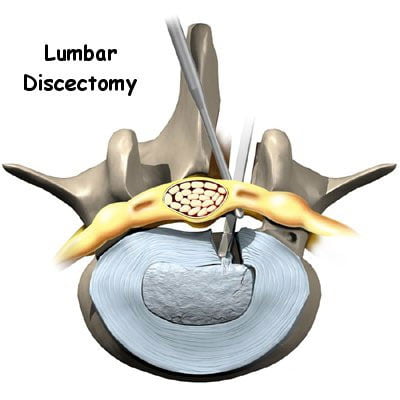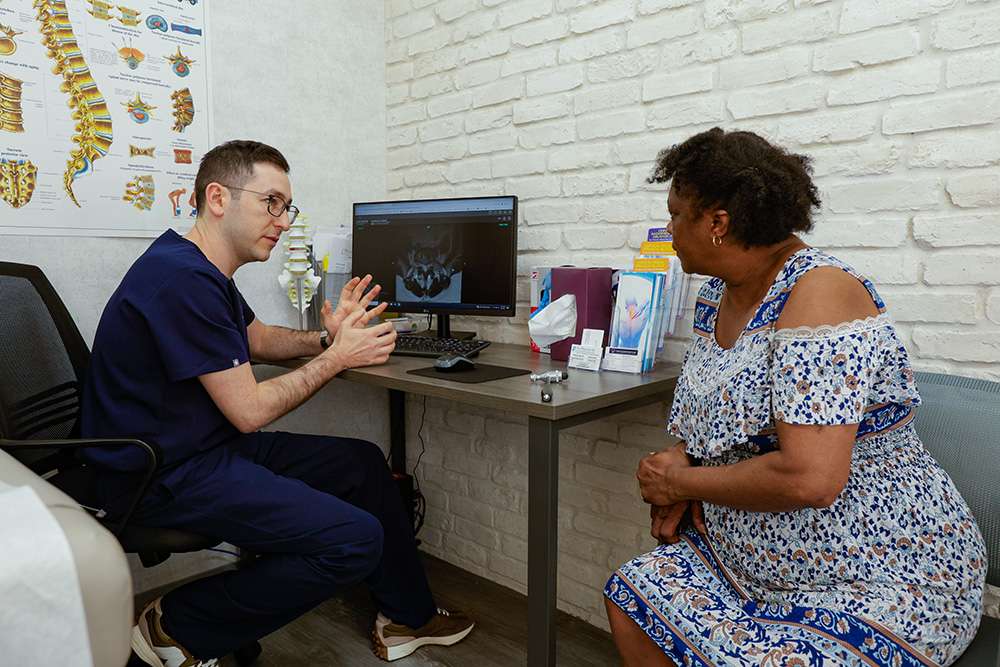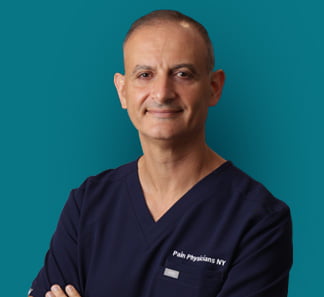When it comes to correcting painful back conditions, there’s no such thing as “the good old days.” Open surgery as done in the past required surgeons to make large incisions, often cutting muscles that were in their way. Today, thanks to revolutionary new surgical techniques and the expertise of the best pain doctors in New York, many back pain conditions can be treated on an outpatient basis with procedures like a lumbar discectomy, leaving you with minimal to no lingering pain. Call pain management in NYC today for an evaluation.
Your back is made up of bones, called vertebrae, and the cushions between each bone, called discs. When you injure one of these discs or it suffers from deterioration, a disc can become misshapen, bulging or leaking into the surrounding areas. Sometimes nerves are close enough to be impinged by the invading material, causing pain and discomfort.
If you’re dealing with sciatica or leg pain from a pressured nerve in your lower back, a lumbar discectomy outpatient procedure is especially effective. Removing the encroaching disc material and relieving the pressure against the nerve often results in a significant reduction in pain, tingling and discomfort.
The Conditions that a Lumbar Discectomy Treats
 Lumbar discectomy surgery is an effective method for dealing with a number of back pain conditions. Some of these include:
Lumbar discectomy surgery is an effective method for dealing with a number of back pain conditions. Some of these include:
- Bulging or herniated discs, also called a disc prolapse
- Spinal stenosis
- Lumbar disc degenerative disease
- Cervical radiculopathy
- A pinched nerve
- Sacroiliac joint dysfunction
- A compression fracture
- Hypertrophic or enlarged ligaments
This surgical procedure isn’t for everyone. You may find enough pain relief through a combination of rest, medication, physical therapy and activity modification. But if you don’t experience a decrease in your symptoms, your pain doctor at pain clinic in NYC may recommend lumbar surgery as a viable option.

Microdiscectomy vs. Percutaneous and Endoscopic Discectomy
Depending on the source of your pain and your overall health, your doctor may choose between one of two different methods of spinal discectomy. The goal of both minimally invasive surgical procedures is to repair or remove offending matter while minimizing the damage to your muscles, tendons and surrounding tissue. The two procedures are defined as:
- Microdiscectomy. Your NY pain management specialist carefully positions the incision, which is just an inch to an inch-and-a-half in length, parallel to how your muscles line up. It’s almost like peeking between blades of grass to see past them versus chopping them down to get a better view. Spreading your muscles gently apart allows for a much less traumatic procedure and much quicker recovery time. Magnification and fluoroscopic techniques also give your doctor a better view without damaging the surrounding tissue.
- Percutaneous discectomy or endoscopic discectomy. Both of these methods require your pain management doctor in Manhattan to insert one or more small tubes into your back. Using imaging technology to guide his movements, your doctor gradually widens the tube, spreading your muscles apart. This provides an operating channel to insert cameras and other instruments. The incisions for these tubes are only a few millimeters wide, so this minimally invasive technique results in decreased post-surgical pain and a quicker recovery.
Because the incisions are so small, all these procedures now provide patients with cervical pain, or neck-related conditions, needed relief in techniques such as an anterior cervical discectomy fusion. In the past, more invasive procedures caused too much damage in this smaller, more delicate area. These methods are usually performed on an outpatient basis, further enhancing your recovery time. In fact, since the offending matter has been removed, most patients report a reduction in overall pain immediately following their procedure.
Benefits of Lumbar Spine Discectomy Procedures
At present, these minimally invasive back surgery techniques are still relatively new. At Pain Management NYC, the top-rated back pain doctors are focused on providing the most up-to-date, but safe treatments. In their capable and experienced hands, any small risks associated with an endoscopic discectomy are drastically reduced.
Compared to conventional back surgery, a spinal discectomy is always superior because you don’t have the disruption of soft tissue that can lead to spinal instability patterns. Damage to tendons, muscle and ligaments may affect your mobility for quite some time, if not permanently. Compare that possibility to the minimally invasive techniques. Less damage to surrounding tissue results in less post-operative pain and quicker recovery times.
After Your Minimally Invasive Spine Surgery
A percutaneous discectomy usually is performed on an outpatient basis with local numbing agents or a gentle twilight anesthesia. To undergo general anesthesia, which you or your doctor may sometimes prefer, you need to prepare accordingly. Have someone else accompany you to drive you home and be around to help for at least the remainder of the day.
Your pain doctor in Midtown usually prescribes some pain medication to help with the incision discomfort and any residual pain from your condition. He instructs you to refrain from sitting for long periods of time, practice some deep-breathing techniques and not lift objects heavier than five pounds for up to two weeks or until he gives you the go-ahead.
You may resume your job, if it’s not physically challenging, within a few days. Walking is strongly encouraged. Your doctor may prescribe other physical therapy exercises in the days ahead. Following your doctor’s instructions makes this surgery the most successful possible. So don’t wait for your lower back pain to get worse. Contact Pain Management NYC today!

Boleslav Kosharskyy, MD, is a top-rated, best-in-class interventional pain management doctor. He is board-certified in Anesthesiology, Interventional Pain Medicine, and Palliative Care.
Dr. Kosharskyy is an Associate Professor of Anesthesiology and Rehabilitation Medicine at Albert Einstein Medical College. He’s also the Associate Medical Director of Pain Medicine and Director of Anesthesia for the Joint Replacement Center at Montefiore Medical Center and Albert Einstein Medical College.
He is an active member of the American Society of Anesthesiology (ASA), the American Society of Regional Anesthesia and Pain Medicine (ASRA), and the New York State Society of Anesthesiologists (NYSSA)
